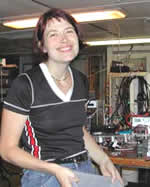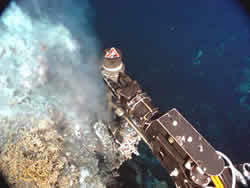|

Teacher's Report
Bill Hanshumaker, Educator at Sea
Researcher Interview:
Amanda Bates
Graduate Student in Biology at the University of Victoria

Amanda
Bates, graduate student in the biology department at University of
Victoria, stands beside the gastropod pressure chamber (lower right. |
|
Bill:
What is the focus of your research on this cruise to Axial Volcano?
Amanda:
I am interested in the distribution of three different gastropod (snail
and limpet) species found in the vent systems. These three species are
found in different vent habitats and I want to discover if they have different
temperature preferences. I chose temperature because it is correlated
to oxygen, pH, sulfide, and vent flow rate and these are factors that
define habitats at the vents.
Bill:
How do you study these animals?
Amanda:
Initially I used a vertical pressure chamber, but these snails are geotactic
(orient to gravity) and when you bring them up to one atmosphere their
impulse was to climb up. I needed to set up a horizontal pressure chamber
with a temperature gradient that has a high to low range. I also designed
similar chambers to use underwater at the vents.
| |

The ROPOS claw holds the hot fluid sampler
probe in a "bee hive" at the top of Inferno vent. |
Bill:
Where do you go from there?
Amanda:
It's intriguing because a really hard thing to know is when to stop an
experiment. When is there an endpoint? In my first experiment on the Thompson,
I used three species of gastropods and let them acclimate at 4 degrees
in our walk-in cooler. Then I increased the temperature up to 12 degrees
and they scattered. Next I heated up one side to 35 and cooled the other
to 2 degrees by continuously adding ice to the other side for 5 hours.
What I found was neat! For the first hour the animals moved down the chamber
remaining in the 20-degree range, but they didn't move into water that
was warmer than 20 degrees. But after three hours they all moved to the
area in the chamber where the water was 14 degrees. What I'm doing now
is replication over a smaller temperature range of 20 to 2 degrees and
see where they go after 5 hours. I hope to use this information to determine
why these animals are found in different vent habitats. My current hypothesis
is that temperature can define the habitat where each species is found.
Bill:
What are the names of the species that you're studying?
Amanda:
Aside from the Provanna snail (Provanna variabilis), there's the glob
snail, Depressigyra globulus and Lepetodrilus fucensis, which can reach
incredible population densities. It's called a limpet because of its shape,
but isn't related to the limpets that are common in the intertidal zone.
Bill:
Well, you've been up all night and only had three hours of sleep before
then. It must be as stressful on you as on the limpets.
Amanda:
Well, you might get that idea,
but this is really exciting. Doing experiments at hot vents and on ships
at sea is very challenging. Designing an apparatus that can be handled
with an ROV, and yield clear results is difficult. Plus ship time is limited
to once a year. I've been really busy this year and have spent the last
three months training in molecular work. I'm really interested in the
bacterial symbiants that are found in the gills of gastropods. I think
that some species are "farming" these bacteria and moving them
into their gut. I spent four months planning experiments for this summer,
which are probably the most complicated thing that I've ever executed.
But if the results are clear, then the reward is sweet!
.
|

